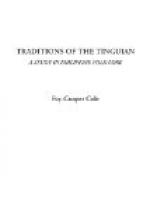[297] A low box-like table used by the Ilocano.
[298] Certain charms are still used by lovers to aid them in their suits.
[299] Pangasinan is a province midway between Abra and Manila.
[300] See p. 19, note 1.
[301] A spirit.
[302] Jars.
[303] This diam is recited by the medium when the spirit house known as balaua is built. See also page 12.
[304] Spirit name for Tinguian.
[305] The greatest of Tinguian ceremonies.
[306] A large house built for the spirits during the Sayang ceremony.
[307] Spirits.
[308] Kadaklan is the most powerful of the spirits. Agemem is his wife.
[309] The names of small buildings or shrines elected for various spirits.
[310] Chanted by the medium while making offerings in the Dawak ceremony which is made for the cure of minor illnesses, such as fever, etc.
[311] A powerful spirit.
[312] The diam recited during the Pala-an ceremony.
[313] The east.
[314] Feathers attached to a stick, which serve as hair ornaments in the Sayang ceremony.
[315] Spirit name for Tinguian.
[316] See p. 171, note 2.
[317] Chanted by the medium, over the offerings given to aid in the cure of a sick child, or to stop a child from incessant crying.
[318] The ceremony.
[319] Diam recited during the Sangasang ceremony in the town of Lumaba.
[320] Chanted when the Sangasang ceremony is made for sickness, or to take away a bad omen.
[321] Spirit name for the earth.
[322] See p. 172, note 4.
[323] See p. 22, note 3.
[324] Chanted when the ceremony is made to remove a bad sign.
[325] An omen bird.
[326] The true omen bird.
[327] Diam recited during the Sangasang ceremony held to remove continued misfortunes.
[328] Several native names which have no exact English equivalents are used here.
[329] Woven bamboo used on ceilings.
[330] This diam was chanted during the Ubaya ceremony in Villaviciosa, an Igorot town much influenced by Tinguian. The Ubaya is also held in Lumaba, a Tinguian settlement.
[331] No one is allowed to enter the town after the ceremony begins.
[332] The most powerful of all spirits.
[333] See p. 13.
[334] See p. 13, note 1.
[335] See p. 12.
[336] A somewhat similar tale, current among the Dayak, will be found in Roth, The Natives of Sarawak and British North Borneo, Vol. I, p. 309 ff.
[337] A small spirit house built during the bawi ceremony.
[338] A kind of grass.
[339] Account concerning the guardian stones at Patok.




